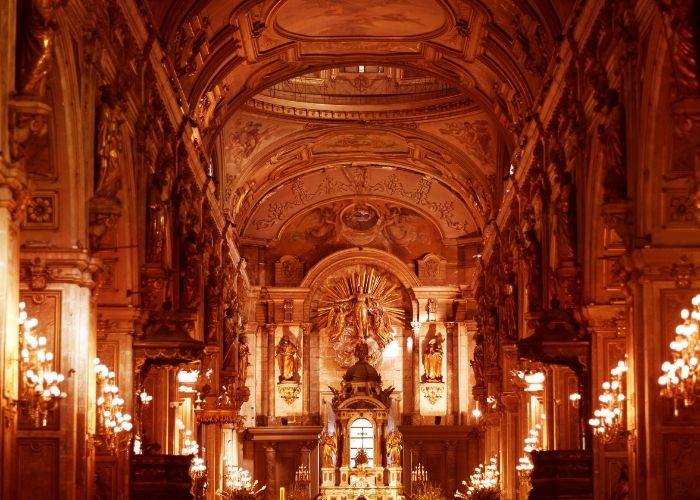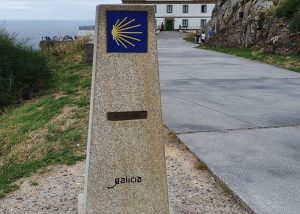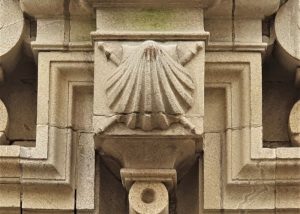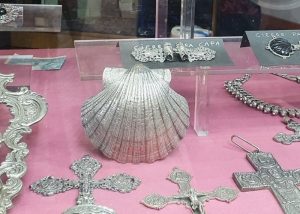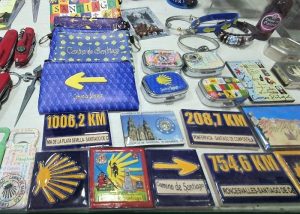SANTIAGO DE COMPOSTELA – For centuries, pilgrims have walked El Camino de Santiago. The route is more popular than ever. In fact, you cannot speak about the route because there are several roads to – in this case – Santiago de Compostela.
More and more people are making the pilgrimage to Santiago de Compostela. In the past, this journey was only made for religious reasons. However, today there are also many hikers who travel the famous route through northern Spain for other reasons.
Background
The Apostle James the Greater, Santiago el Mayor, was a disciple and one of the Twelve Apostles of Jesus Christ. Between 41 and 44 AD James was beheaded in Jerusalem by order of King Herod Agrippa. According to a legend, after his martyrdom, James’ body is said to have been placed in a stone boat by two of his followers, Athanasius and Theodorus, which, driven by an angel, arrived at the coast of Galicia. James’ body was buried near Mount Libredón. At that time, there was most likely a Roman settlement called Asseconia here.
The Cathedral of Santiago de Compostela
The tomb fell into oblivion until, early 9th century, the hermit Pelayo was mysteriously led to the tomb by a star. Bishop Teodomiro de Iria recognised this as a miracle which he reported to King Alfonso II of Asturias. As a result, the king ordered the construction of a church on this site. Later, the Cathedral of Santiago de Compostela was built on the remains of this church at the initiative of Alfonso VI and Bishop Diego Pelaez.
Construction started in 1075 and the cathedral with its nine towers was not completed until 1211. Over the centuries, the building has undergone significant changes. Furthermore, in the 17th century, the old Romanesque north portal disappeared and Baroque elements were added in the 18th century.
Although Galicia was ‘the end of the world’ at that time, many pilgrims traveled to this place. The road only became really important around 1120, when Pope Callixtus II decided to grant full clemency to the pilgrims who make a pilgrimage during a Holy Year, Año Santo Compostelano or Año Jacobeo. A Holy Year is when July 25, the day on which the death of the Apostle James is annually commemorated, falls on a Sunday. That will be the case in 2021. Because the pandemic has thrown a spanner in the works, the Pope has announced that the Holy Year will be extended until December 31, 2022.
Scallop
The scallop shell is already an ancient symbol of the Camino de Santiago. In French it is called a Coquille Saint Jacques and in German a Jakobsmuscheln. Furthermore, the scallop shell is said to have become a symbol of the pilgrimage because this shell. The shell, which is easily found on the Galician coast, was taken home by pilgrims as proof that they had completed the route.
There are several legends about the origin of the symbol, which sometimes contradict. Firstly, there is talk of a drowning man who was rescued by James and who was completely covered with shells. Another, much more common, story is that James himself was covered with these shells in his grave.
The apostle´s miracle
Lastly, legend tells of a young groom who celebrated his wedding on the beach. Quite unexpectedly, his horse ran amok, after which the groom ended up in the sea and disappeared into the waves. At the same moment James’ stone boat with his two disciples passed by. Rider and horse were rescued, but came out of the sea completely covered in shells. All present rejoiced at that miraculous salvation by the apostle. Even before he landed in Galicia, he had already performed a miracle.
Visibly wearing the shell on the hat or on the jacket provided protection against brigands, who left the wearers alone on the basis of a code of honour (but probably also because they knew that the poor pilgrims had nothing to gain after all).
Everywhere along the pilgrimage route you will come across the symbol of the shell as a marker of the route.
In addition, the shell represents fertility, birth or rebirth and is often depicted in paintings with Christian scenes. One of the most famous paintings is “The Birth of Venus” by Botticelli. However, this has little to do with the pilgrimage.
Passport and certificate
In the Middle Ages, a pilgrim was given a credential from a pastor or bishop stating that the wearer was really a believing pilgrim. The reader was requested to provide shelter, food and assistance to the pilgrim. Nowadays you need a pilgrim’s passport, la credential. A pilgrim can get certain privileges with this. The most important privilege is to be “hospitably received”. There is space in the passport to collect stamps, which are available everywhere along the route. Here you can find an overview where you can get those stamps exactly.
If the passport contains sufficient stamps, a certificate, La Compostela, can be collected at the pilgrim’s office in Santiago on presentation of this. To obtain this, only the last stamps on your passport are looked at. For the trip on foot, these are the last 100 kilometres, the last 200 kilometres by bike and the last 300 kilometres on horseback.
The pilgrim’s staff
One of the indispensable attributes of the pilgrim was the pilgrim’s staff. This was a wooden stick with usually an apple-shaped convex knob at the top and a wrought iron point at the bottom. The walking staff had practical functions as well as moral functions. Firstly, the staff made the walk easier and provided extra support in case of fatigue or overload or on bad roads. In addition, it could usefully serve as a defense against highwaymen and stray dogs and wolves. Nowadays many pilgrims walk with two sticks because it appears to be better for your body.
World Heritage of UNESCO
Since 1993, the Spanish part of El Camino Francés has been on the UNESCO World Heritage List. Three years later, the French routes were also added. As of July 2015, a number of northern routes are also on the UNESCO World Heritage List. These are El Camino de la Costa, Camino Interior, Camino Liebana and Camino Primitivo. Other places, such as the old town of Santiago de Compostela and the walled city of Lugo (on the Camino Primitivo) are already on the list.
Routes
You could start the pilgrimage route to Santiago de Compostela from the front door of your own home. However, there are several well-known routes from various countries in Europe that all but one end in Santiago at the cathedral:
El Camino Frances
The French route, El Camino Francés, is the most popular and is 780 kilometres long, divided into 33 stages. The route owes its fame to the “great variety of landscapes and the great historical and monumental wealth.”
El Camino Norte
The northern route partly follows the ancient Roman road Via Agrippa and is one of the oldest routes to Santiago. The advantage is that it is a quiet route, because it is less known. It is one of the longest (853 km) and most difficult routes with overnight stops only every 20 to 35 km.
El Camino Primitivo
El Camino Primitivo of 321 kilometres long is considered the first pilgrimage route to Santiago de Compostela. King Alfonso II is said to have travelled it first from Oviedo to Santiago in the year 814. After arriving in Santiago, he ordered a church to be built over James’ tomb.
Via de la Plata
Via de la Plata was once a Roman road that connected the Roman city of Itálica (near present-day Seville) with Asturica Augusta – today’s Astorga. The route covers approximately 1,000 kilometres. One of the most beautiful parts of Via de la Plata is the amount of old stones that mark the original road. Despite the fact that this route is also called the Silver Route, the word ‘plata’ does not refer to silver, but to the Arabic word BaLaTa (balatat). The translation of this is tiled or cobbled road.
After their invasion, the Moors gave the Roman roads this name to distinguish them from the bridleways. Over time, BaLaTa changed to BlaTa, Plata. Because plata is the Spanish word for silver, this route has been mistakenly called the silver route. However, the name of this road has nothing to do with silver.
El Camino Finisterre
Finisterre was also called the ‘end of the world’ by the Romans. This was probably the place where the apostle James first set foot on land. There is a tradition that the pilgrim discards his old clothes here and then burns them as a symbolic act of renewal. This is the only route that does not end, but starts in Santiago. Depending on the route, the tour is 87 or 119 kilometres long and consists of 3 or 4 stages.
El Camino Portugues
The Portuguese route starts in Lisbon and is the most popular pilgrimage route to Santiago de Compostela after the French route. Most pilgrims take about 25 days on the total route of about 630 kilometres. From Porto you can choose from two routes: The Camino Central through the interior (241 km) and the Camino Costal along the coast (265 km).
El Camino Ingles
El Camino Inglés is one of the shortest routes to Santiago de Compostela. The route was traditionally used by pilgrims from Scandinavia, England or Ireland who sailed by sea to Ferrol or A Coruña and walked on overland to Santiago.
El Camino Antartida
El Camino Antártida is the newest route to Santiago de Compostela, which opened on December 30, 2015. On February 28, 2016, the first group departed from Antarctica. They arrived in Santiago on July 7, 2016. This makes this route the longest of all: 14,075 kilometres.
Also read: Stroll to your peace of mind on the Camino de Santiago
